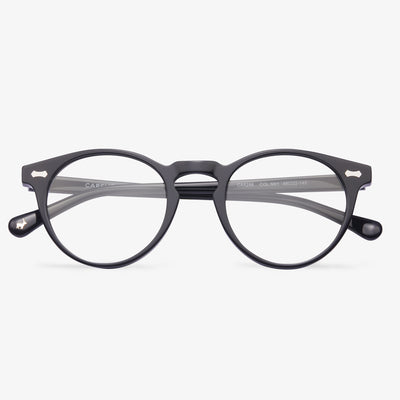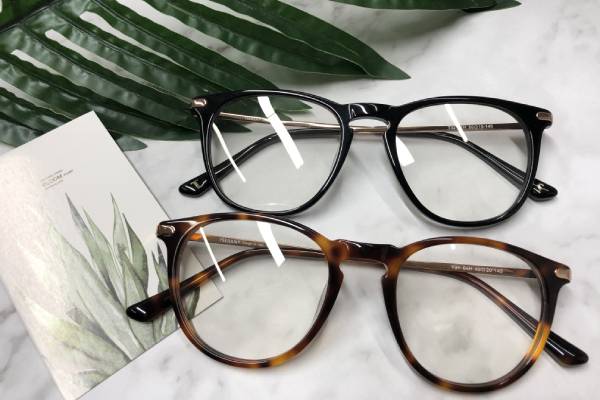Different Type of Lenses: How to Choose
In this section, we will list some of the lenses for glasses.
Plastic lenses: In 1947, the Armorlite Lens Company in California introduced the first lightweight plastic lenses. The lenses were made of a plastic polymer called CR-39, because it was the 39th formulation of a thermal-cured plastic developed by PPG Industries in the early 1940s. Plastic lenses are light and low cost.
Polycarbonate lenses: polycarbonate lenses were first introduced in the 1970s and they have become increasingly popular anad remained for a long time. Polycarbonate glasses are slighter and significantly more impact-resistant than CR-39 plastic, making them a preferred material for children’s eyewear, safety glasses, and sports eyewear.
What is blue light?
Blue light is an important part of natural light, and it is visible light with a wavelength of 400nm-500nm in the spectrum. Blue light can be divided into short-wave blue light (harmful blue light) and long-wave blue light (beneficial blue light). Short-wave blue light harms people’s vision and causes specific diseases, while long-wave blue light helps people maintain normal physiological functions, regulate biological rhythms, and treat specific diseases.
Blue light can be seen everywhere in daily life. In addition to blue light in the sun, electronic products such as TVs, computers, mobile phones, ipads, and LED lights also produce blue light in our daily.
Have regular professional examinations.
The rimless glasses frame is directly punched on the lens and fasteners are added to fix the lens. It is easy to loosen the lens after long-term wearing. Therefore, it is recommended to regularly check and correct the glasses in the store when wearing rimless glasses. If the protective nut of rimless glasses falls off, stop using them immediately and repair them in time before wearing them. If screws and other accessories are loose, etc, be sure to go to the optical shop by the professional processing division to adjust.
Transitions® Photochromic Lenses
When you step outside, it immediately begins to darken. The lenses help prevent harmful blue light from digital devices, screens, and sunlight to help reduce glare and prevent eye strain. They have the function of 100% UV blocking,anti-reflection treatment with blue light protection. They can constantly adapt to changing daylight conditions to reduce excess light and optimize color contrast and polarized light to prevent dazzle. They filter out excess light to provide maximum comfort. And provide high contrast and minimize glare. They provide increased color recognition and depth perception.
Wear blue light glasses before bed.
Because blue light can have a huge impact on your sleep cycle, these glasses are pretty important before bed. So, putting on blue light glasses before you go to bed can help increase melatonin, which in turn helps you get a good night's sleep. Sleep glasses display a wider range of blue light, which naturally helps you sleep better and triples melatonin production. They have a slight lens color because they target a wider range of light, but are best for sleeping. In addition to sleep glasses, there are nearly transparent optical glasses that filter out blue light levels to help treat digital eye strain, which is made up of headaches, blurred vision, and eye strain.
The origin of modern eyeglasses
The origins of modern glasses can be traced back more than 1,000 years. In the Middle Ages, the reading stones used by monks were glass spheres, sometimes filled with water and placed on objects to magnify them.Glassblowers in Italy created reading stones, similar to modern hand-held magnifying glasses. The reading stone can be placed on the wearer's nose or in front of the face. Later, Spanish craftsmen built the first cobra-framed temple in the 17th century. They tie ribbons or strings to the frames and tie them around the user's ear.
In the 18th century, Edward Scarlett created the first wearable glasses, providing more comfort for eyewear wearers. These early glasses had glass lenses embedded in heavy frames made of wood, lead, or copper. Natural materials of leather, bone, and horn were later used to make the frames. In the early seventeenth century, lighter steel frames were invented. As eyewear continued to evolve and prescription accuracy improved, the trend for eyewear to become more fashionable began. In the 18th century, bifocal lenses appeared, making it possible to correct upper myopia and lower presbyopia. Later glasses were designed to be fixed by a ribbon or by applying pressure to the bridge of the nose. In the 1980s, plastic lenses were introduced, providing a more durable alternative to glass lenses. Ultimately, the glasses used today are the result of centuries of technological and intellectual advances.
About Glasses Donation
Some enterprises adhere to the quality of survival. They always adhere to the credibility and development of the business philosophy, investing in public welfare undertakings and fulfill their social responsibilities. They donate glasses, have free vision tests, and put forward reasonable love eye care advice according to the results of the test to the public.











































